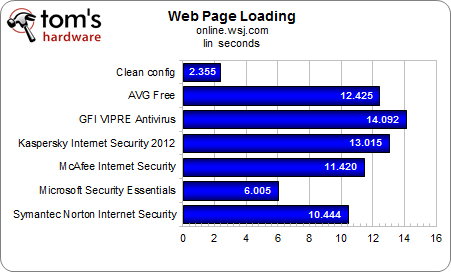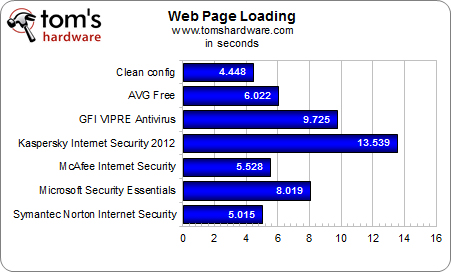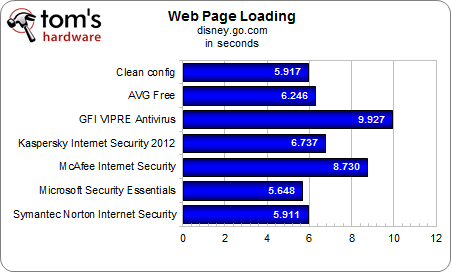Do Antivirus Suites Impact Your PC's Performance?
Most of us are now fairly confident that our antivirus scanners are doing their main job of protecting our systems from malicious pests. But what are those scanners doing to system performance behind the scenes? Are some scanners better than others?
Web Page Load Time
We have PCMark for our synthetic tests, so we wanted to use three real, commonly traveled, and highly stuffed Web pages for our assessment of AV impact on real-time browsing. As you might expect, pages can vary considerably in how they integrate third-party elements, such as hosted video and banner ads. We suggest considering all three result sets together.
We can only make a few general statements in looking over these charts. First, we see that the clean configuration is almost always the fastest. This is to be expected. Only once, on the Disney home page, does a single product slip in with a slightly faster score, and we attribute this to temporary Internet congestion slightly skewing our clean config numbers.
Of the three charts, we prefer the Wall Street Journal results as being the pattern that most fit our expectations. It may be that Microsoft puts the least effort into advance page scanning and so reports back the fastest results of the AV contestants. We can debate whether the other products are simply slower and more cumbersome or if they do a more thorough job of applying reputation analysis and other factors to provide advance warning to users if needed. Either way, we like seeing that the AV products are doing something.
Is a 10-second slow-down worth worrying about? Yes. Believe it or not, a 10-second delay experienced 100 times in the course of a day means more than 16 extra minutes of sitting around waiting for pages to load. That’s an entire break time broken up so minutely that you have no time to actually enjoy the break. On the other hand, consider the potential time lost and heartbreak gained by picking up malware from an unscreened site. We’ll take the 16-minute loss and hope AV vendors can improve their scanning algorithms in the future.
Get Tom's Hardware's best news and in-depth reviews, straight to your inbox.
-
dogman_1234 Regardless what anyone says: Using McAfee is like using a Glad garbage bag as a condom.Reply -
Martell77 I've been using Trend Micros AV since y2k and haven't had a reason to switch. Because of the systems my clients have I never recommend Norton or McAfee and if they have it I always recemmend they switch. Its truely amazing how the performance of their systems increases after getting rid of those AVs, especially Norton.Reply -
soccerdocks On the scanning time page there is an error in the second graph. It also says first run.Reply
Also, the timing of this article was excellent. I had just been doing some research about what anti-virus software I should switch to, mainly based on performance, but I guess I just got all the information I needed. -
compton Some of the results seem mysterious, like all the times the no-AV configuration scored lower in many tests than it should be faster in. Is it possible that using the Wildfire as the system drive instead of the platter would have eliminated this behavior? In general, I hope there is a second part to this that does include SSD runs. I would think any advantage AV products have vs. the no-AV config would evaporate.Reply
I stopped using AV products on my personal systems back in 2003. Norton back then was god-awful on a Pentium 4 systems, seemingly crushing the life out of a system. Even with a first generation WD Raptor 36GB my P4 2.6 would choke not only with Norton, but also McAfee. I might not use AV software, but I do put it on my family members' systems when it doesn't kill performance. In that respect these modern solutions seem much better.
-
ChiefTexas_82 On my Pentium D I have to run McAfee when I'm gone for a good while or sleeping as my computer slows to a crawl during the scan. Even bringing up the menus to stop the scan take way too long.Reply -
darkstar845 Why didn't they test this on a computer with average specs? The 8gb ram and very fast CPU might be offsetting the impact that the AVs put on the computer.Reply -
bit_user Thanks for this. I remember the bad old days when AV could make software builds take several times longer.Reply
-
cdhollan While my comment is completely tangential, but my inner chemical engineer can't resist making a small correction in what is otherwise a great article:Reply
>>Apparently, this is somewhat like saying you can boil water at 230 degrees Fahrenheit instead of 260 degrees. As long as the water is at 212 degrees or higher, no one really cares. -
rottingsheep installing vipre speeds up your computer?Reply
i think something is wrong with your numbers. -
Amazed ESET is not being tested considering it sells itself on its performance over the competition while maintaining the same levels of protection.....Reply


